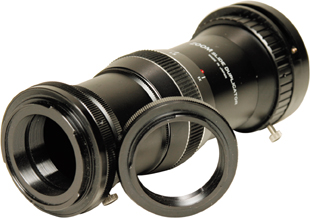Hack 12 T-Mounts and Other Threaded Tricks
| < Day Day Up > |
| Digital SLR users can connect their camera bodies to a variety of bargain optical attachments by using one of the most enduring adapters of all: the T-mount . The best camera for photographer-hackers is certainly the digital SLR (DSLR). From outward appearances , these cameras look just like the 35mm single lens reflex (SLR) models that photographers have been using for decades. SLRs are distinguished by the ability to remove the lens from the body and replace it with another type, which makes them extremely versatile. The other advantage is that you view the picture through the same lens you use to take the photo, so what you see is what you get. DSLRs work the same way. The only difference is that they have an image sensor instead of film. DSLRs are a lot of fun for hackers, because when you remove the lens, you can attach just about any optical accessory to the camera body, including microscopes, telescopes, slide copiers, and much more. At first, you might hold the microscope in one hand and the camera body in the other and wonder how the heck these two items can work with each other. Generally, this happens via some type of adapter. For example, telescopes have an adapter that replaces the eyepiece, and you attach your camera to the adapter. The same goes for microscopes and other optical goodies . But you still need a way to connect your camera to the adapter. If you don't want to shell out the big bucks for a custom adapter made by your camera manufacturer, you can make this connection by using a common photographic tool called a T-mount . T-mounts are simple devices, really nothing more than a thick metal ring. On one side, there's a bayonet-styled mount (like the one on the base of your camera lens) that attaches the ring to your camera body. Inside the ring, you'll notice there are threads. These are a standard size that most adapters in the universe screw into snugly. So, all you have to do is screw the optical adapter (as for a telescope ) into the T-mount, tighten it, and then attach the unit to your camera body. You're in business! Now, your camera will mount on whatever optical lens the adapter is designed for. It's a good idea to find a T-mount that works with your digital camera. Once you do, just about any optical adapter you find in the bargain bin will now mount on your state-of-the-art camera. For example, my slide copier is over 20 years old, but it works great on my state-of-the-art DSLR because I have a T-mount to hook the two together, as illustrated in Figure 1-13. Figure 1-13. T-mount with slider copier attachment 1.13.1 Adapters Made by Scope ManufacturersMany spotting-scope and telescope manufacturers provide camera adapters for their products. For example, Kowa (http://www.kowascope.com) makes a photo and video adapter (TSN-VA1); you simply slide the camera lens into the adapter, tighten the mounting screw, and connect it to a Kowa spotting scope. If your camera has a filter ring, Kowa's TSN-DA1 adapter will screw into it. Many other scope manufactures make similar adapters. If you plan on buying a telescope or spotting scope, be sure to check the accessory line for camera adapters. 1.13.2 The Simple Reversing RingT-mounts have a first cousin called the reversing ring . A reversing ring looks similar a to T-mount, but instead of having internal threads to attach a variety of optical accessories, it has external threads that screw into the filter ring on the front of your lens. This enables you to literally reverse your lens so that the front optic is mounted to the camera and the back optic is pointed out to the world. Why the heck would you want to do such a thing? Well, when you turn your lens around, you increase its magnification. So suddenly, thanks to this little round piece of metal, you can get closer to your subjects for some serious macro photography. Some camera makers , such as Nikon, make special reversing rings for their electronic cameras, with delicate contacts near the lens mount. Make sure you get a reversing ring that's suitable for your camera; otherwise , you might damage its electronics. 1.13.3 Extension TubesIf you don't like the idea of having your lens turned around, there's another economical way to increase magnification for close-up photography. Extension tubes are "spacers" in different widths that go between your camera lens and its body. The more you increase the distance, the higher your magnification will be. Kenko makes automatic extension tubes for a variety of camera models that are readily available at many retail camera stores. Extension tubes have the advantage of retaining some or all of the camera's functionality, such as adjusting the aperture, because they have the same contacts as your lens. Reversing rings don't provide that functionality. The major drawback of extension tubes is that the farther you move the lens away from the camera body, the darker the image becomes, and the more light you need for a good exposure. When using tubes in low light, it can be hard to focus on your subject. Most people invest in DSLRs so that they can change lenses more easily. But the less obvious advantage is that, by using a few of these simple adapters, you can mount your camera to just about anything with a lens. And that opens up a whole new world of photography. |
| < Day Day Up > |
EAN: 2147483647
Pages: 161
- Using SQL Data Definition Language (DDL) to Create Data Tables and Other Database Objects
- Using SQL Data Manipulation Language (DML) to Insert and Manipulate Data Within SQL Tables
- Working with Queries, Expressions, and Aggregate Functions
- Understanding SQL Subqueries
- Writing External Applications to Query and Manipulate Database Data